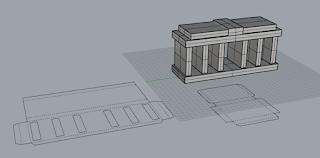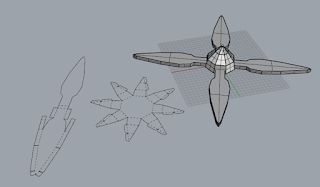So this was supposed to be a blog post on my great success in creating something cool and interesting for this assignment and writing about all the things we were supposed to, but given that just about everything went wrong I don't think that'd be appropriate.
My journey through the topography of errors begun with the in-class mini critiques that were run on our 10 concept mashup pieces. Our group was fairly evenly divided on which of my 10 concepts was the most successful. It was split between the Jet Bike, and the Rocket Mug seen below.


Those who backed the jet bike did so because of it's potential to be a very technically challenging model and for the possibility of it to be very visually striking if done right, but we'll come back to this later. On the other hand the Rocket Mug was said to be more successful because of its conceptual properties. That it could be a more thought provoking, "artsy" piece if some viewers were added around the edge of the mug with maybe some scaffolding around the mug to make it look a little more like a launch pad. While I agreed with all criticisms of my concepts I remained 50/50 split on which I wanted to carry through to this assignment. It was a battle between strong visuals and strong concept. After some thought I came to the conclusion that the Jet Bike would be a more challenging model to move foreward, and wanting a challenge, I chose it.
I took the original concept of the motorcycle-with-jets-instead-of-wheels into Tinkercad and began hacking the thing up, adding many of my own details, and attempting to recreate a realistic paint job. That paint thing is what bit me in the ass. "This is going to look so good". "Bryan's going to be super impressed". No. About three quarters of the way through the completion of the Jet Bike model I realized the fatal mistake I had been making for the last who knows how many hours. Every time I finished a sub assembly I would group it in Tinkercad then activate multicolour. I swear you could've seen a little bit of my soul die when I realized that all of the work I had put into colour detailing would dissapear the instant I moved my model into Rhino 5.0. For those interested this was how far I got into my refined model of the Jet Bike. I'll probably still continue to work on it as a little side project in my own time.

At this point my options of where to go with the Jet Bike were very limited, so I turned to the other favorite concept in my critique, the Rocket Mug. While being a much simpler model I knew it was something I could polish up quickly to create an okay final product. Along with that I personally find the idea of a shuttle coming out of coffee mildly amusing. The power of coffee shown in a mix of mashup and juxtaposition. On Sunday night I begun to rebuild the idea of a space shuttle launching out of a coffee cup from the ground up using all new Thingiverse models for both the shuttle and the mug.
I completed the refined model in a relatively short amount of time but was quite pleased with the result, so I saved it and prepared to render the next day in Rhino.
A key element in my mind to a render looking good is the colour and material applied to certain details within the model. So before I opened my Rocket Mug in Rhino I grouped the elements I wanted to have the same material with Tinkercad. This is where things get rocky again. Apparently Rhino has a limit on how many separate meshes it can import within a single .stl file. So when I pulled up my model in Rhino it had decided to lump unrelated objects together in layers. For example it made one which included 2 sitting men, the coffee, and the fuel tank and boosters for the shuttle. Obviously the render would look like trash if those 6 elements were all the same colour and material so I moved back into Tinkercad to try to reduce the amount of separate objects in my model. I ran through around ten variations of my model trying to get it to read properly in Rhino. But with the bare minimum I could do, Rhino still was clumping things together. I figured I had got to the point where the model was the best it could be so I decided to screw it and move forward to the renders themselves.
You like problems? How about another? The final problem that backhanded me across the face came from a single point of light I created to illuminate my model for the render in Rhino. For whatever reason Rhino thought it would be a good idea to turn every object into a pure black silhouette every time I created a light point. With this very obtrusive obstacle in my way of properly setting up my renders and finally finishing this assignment I said "screw it" once again and did two renders of the Rocket Mug using only the standard ambient light provided by Rhino. As expected they look like trash. In an attempt to redeem myself I did a render with a point light by eyeballing the positioning for it and hoping for the best. Trash again. Here's what this shitty-shit-shit ended up looking like rendered in Rhino.
And as a real cherry on this cake from hell I realized after I had left ACAD that 6 renders were required of our final models, not 3. So uh, yeah. Lesson learned I guess.






















